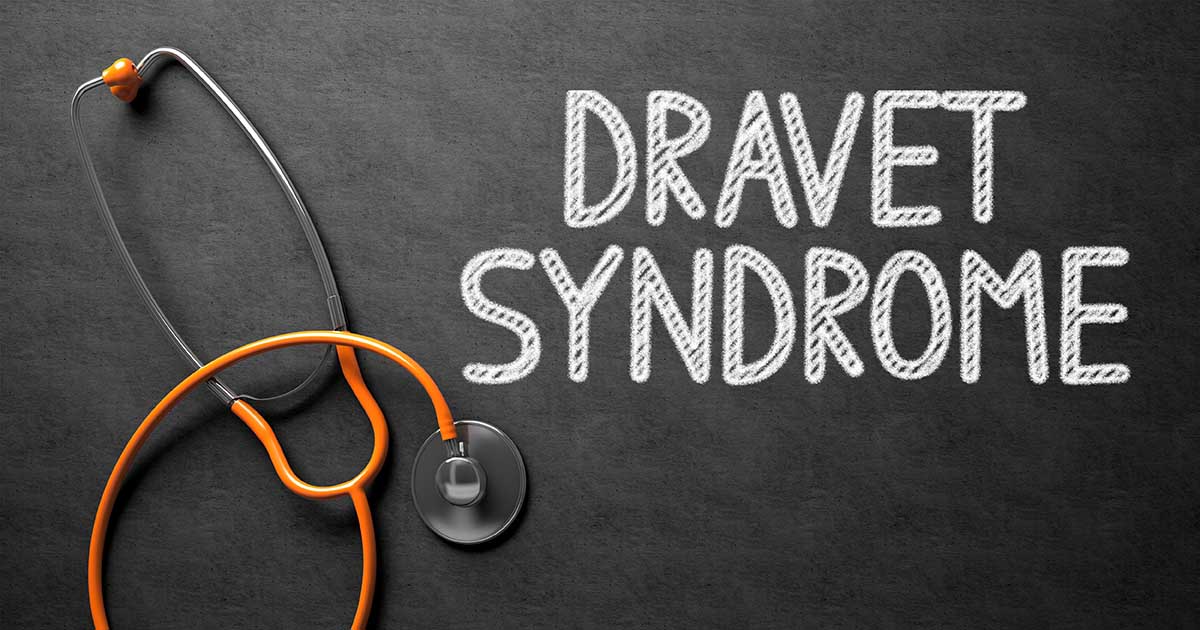Dravet Syndrome

Learn More:
Find Your Local Epilepsy FoundationWhat is Dravet syndrome?
Dravet syndrome is a rare, genetic epileptic encephalopathy that gives rise to seizures that don’t respond well to seizure medications. It begins in the first year of life in an otherwise healthy infant.
- Before 1989, this syndrome was known as epilepsy with polymorphic seizures, polymorphic epilepsy in infancy (PMEI), or severe myoclonic epilepsy in infancy (SMEI).
- The disease begins in infancy and is lifelong.
Some more important points:
- Infants have normal development when seizures begin. Yet as seizures continue, most children develop some level of developmental disability. By later childhood, most children also develop a crouched walk.
- Diagnosis is often delayed. MRI (magnetic resonance imaging) and EEG (electroencephalogram) tests are usually normal in infants at first.
- About 8 out of 10 people with this syndrome have a gene mutation in SCN1A that causes problems in the way ion channels in the brain work. This mutation is most often not inherited from the parents. It is considered a de novo or "new" mutation in the child. Not all SCN1A mutations are associated with Dravet syndrome.
What is it like?
Seizures generally start within the first year of life. The first seizure often happens with a fever and may be a tonic-clonic seizure or a seizure involving clonic (jerking) movements on one side of the body.
- These seizures are often long (lasting more than 5 minutes) and can result in status epilepticus (when seizures do not stop or occur close together). Such seizures typically recur every few weeks in infancy and early childhood
- Other seizure types seen in children with Dravet syndrome include
- Myoclonic seizures (brief shock-like jerks of a muscle or group of muscles) starting between 1 and 5 years in 85% of children with Dravet syndrome.
- Tonic-clonic seizures
- Atypical absence seizures
- Atonic seizures
- Focal aware or impaired awareness seizures (previously called partial seizures)
- Tonic seizures, mainly in sleep, may appear in later childhood
- Non-convulsive status epilepticus where the child has decreased responsiveness associated with eye flutter and twitching of the body for prolonged periods of time
- After the first febrile seizure, seizures can happen without a fever. However, these children are very sensitive to infections and frequently have seizures when they are ill or have a fever.
- Seizures can also be triggered by slight changes in body temperature that are not caused by infection, for example a warm or hot bath water or hot weather.
- Many children have photosensitive seizures triggered by flashing lights, patterns, or similar photic triggers.
- Emotional stress or excitement can also trigger seizures in some children.
- Children usually develop normally in the early years. After age 2, they may lose developmental milestones. Yet they often do not progress as quickly as they get older.
- Other problems that may be seen include
- Low motor tone
- Unsteady walking
- Older children and adults may develop a crouched gait (way of walking)
- Growth and nutritional problems
- Problems with the autonomic nervous system, which serves involuntary body functions like the heart, lungs, stomach and intestines
Be Prepared When a Seizure Happens
- Know - and teach others - seizure first aid. It's Stay. Safe. Side.
- Fill out - and share - a seizure action plan so others will know what you want them to do for you.
Who gets it?
- Reports suggest 1 in 20,000 to 1 in 40,000 people have Dravet syndrome. Three to 8% of children who have their first seizure by 12 months old may have Dravet syndrome.
- Seizures lasting more than 10 minutes, seizures occurring on one side of the body, and seizures triggered by a warm water bath in children under 12 months old are clues for a Dravet syndrome diagnosis.
- The most common gene mutation linked to Dravet syndrome is in a gene called SCN1A. When this gene isn’t working properly, sodium channels in the brain (which help brain cells function) do not work correctly. Some SCN1A mutations are associated with less severe forms of epilepsy, which means not all children with these mutations will develop Dravet syndrome.
- Rarely, atypical Dravet syndrome may be associated with other genetic mutations, such as SCN1B, GABRG2, or HCN1. While the clinical presentation may be similar, some patients with atypical Dravet syndrome may require alternate paths of treatment.
- A blood test for the mutation can confirm the diagnosis. Sometimes a gene mutation is not found on testing, but the syndrome may be diagnosed based on symptoms.
- Although the first seizure in infants with Dravet syndrome may be near the time of a vaccine, vaccines do not cause Dravet syndrome. Children should get recommended immunizations.
Understanding genetics can help you& understand& Dravet syndrome. Start here.
How is it treated?
- Diagnosing the child early is critical to proper treatment and achieving the best outcome.
- A multidisciplinary team is needed to address the many ways Dravet syndrome can affect a child and their family.
- Seizure treatment is aimed at finding the best combination of medicines to treat chronic seizures. Rescue medicines are also need to prevent and treat seizure emergencies.
- Getting the best seizure control possible is the goal; however, complete seizure freedom is usually not achieved.
- Getting the best seizure control possible could also help improve a child’s developmental abilities and decrease risk of early death.
- Usually 2 or more seizure medications are needed to treat the multiple seizure types with this syndrome.
- Medications commonly used for Dravet syndrome include valproic acid, clobazam, topiramate, stiripentol, fenfluramine, and cannabidiol. The ketogenic diet is also frequently used.
- The U.S. Food and Drug Administration (FDA) has recently approved three specific medications for use in children with drug-resistant seizures due to Dravet syndrome.
- A purified, oral solution form of cannabidiol (CBD, a part of the cannabis plant), called Epidiolex, was approved in June 2018. In a study of 120 children and teens with Dravet syndrome, 43% of those treated with Epidiolex had a greater than 50% decrease in seizures compared to 27% of those treated with placebo. Side effects seen more often in people taking CBD included diarrhea, vomiting, fatigue, fever, sleepiness and abnormal results on liver function tests.
- Stiripentol (Diacomit) was also approved in August 2018 and should be used together with clobazam. 71% of children treated with stiripentol had a greater than 50% decrease in seizures compared to only 5% treated with placebo. Side effects of stiripentol include sedation, decreased appetite, fatigue and weight loss.
- Fenfluramine (Fintepla) was approved in June 2020 for use in children with Dravet syndrome > age 2 years. In randomized clinical trials, when used without stiripentol, the average seizure frequency decreased by 74.9% in persons with Dravet syndrome who received the higher dose of Fintepla (0.7 mg/kg/d, maximum 26 mg/day) compared to only 19.2% in those receiving placebo (inactive agent). When used with stiripentol, patients treated with Fintepla (0.4 mg/kg/d to maximum dose of 17 mg/day) achieved a 54.0% greater reduction in convulsive seizures than those receiving the placebo. Common side effects included sedation, insomnia, weight loss
- Fintepla is available through a restricted program called the Fintepla REMS program where patients are required to enroll in this program in order to be evaluated for baseline echocardiograms and follow up echocardiograms to look for changes to their heart valves if any with the use of Fintepla (no critical / clinically actionable changes were noted in the studies)
- It’s important to avoid medications called sodium channel blockers as these can worsen seizures in Dravet syndrome. This includes phenytoin (Dilantin), fosphenytoin (Cerebyx, Prodilantin), carbamazepine (Tegretol), oxcarbazapine (Trileptal), lamotrigine (Lamictal), and rufinamide (Banzel). Additionally, the medications vigabatrin (Sabril) and tiagabine (Gabatril) may increase the frequency of myoclonic seizures and should be avoided. A recent study showed that developmental outcomes were worse in children who had been treated with sodium channel agents for longer periods of time.
- The ketogenic diet has been helpful in some people with Dravet syndrome.
- Surgery is not indicated in most people with Dravet syndrome, although vagus nerve stimulation (VNS) may be useful in some children.
- All people with Dravet syndrome should have a rescue medication. Additionally, all children and adults should have a Seizure Action Plan that provides detailed treatment recommendations for seizure emergencies.
- Children with Dravet syndrome should undergo a developmental assessment prior to starting school. Physical, occupational, speech, and social/play therapies are also helpful. An enriched environment is encouraged.
What's the outlook?
- While seizure severity and number can be reduced with appropriate therapy, complete seizure freedom is typically not reached.
- The approval of Epidiolex and Stiripentol offers a new option to treat seizures in people with Dravet syndrome.
- Other health problems need to be identified and treated early. These also affect a child’s development and outlook for the future.
- People with Dravet syndrome have a higher rate sudden unexpected death in epilepsy (SUDEP). Other causes of mortality associated with Dravet syndrome include consequences of status epilepticus and accidental death from injury or drowning.
- Fenfluramine (Fintepla) is now available through the REMS program to which patients have to enroll. While fenfluramine has been associated with heart valve thickening in the past, no cardiac problems have been found so far in the clinical trials.
- While the diagnosis and consequences of Dravet syndrome can be catastrophic, the cause is known. Ideally, more research can be targeted to improve treatment and find a cure.
Find More Information and Support
Dravet Syndrome Foundation, including a video library and educational resources.
National Institute of Neurological Disorders and Stroke (NINDS) at the National Institutes of Health (NIH) on Dravet syndrome
Learn More:
Contact Our HelplineArticles
- Basic Science Research with Spider Venom Increases Understanding of Dravet Syndrome, Proceedings of the National Academy of Sciences (PNAS), August 21, 2018
- Cannabidiol Attenuates Seizures and Social Deficits in a Mouse Model of Dravet Syndrome, Proc Natl Acad Sci U S A, October 2017
- NEJM Publishes Data on Purified CBD, Epidiolex, for People with Dravet Syndrome, New England Journal of Medicine, May 2017
- Mortality in Dravet Syndrome: A Review, Epilepsy & Behavior, November 2016
- Stem Cells Reveal New Epilepsy Mechanism for Dravet Syndrome,Annals of Neurology, September 2013
Resources
Epilepsy Centers
Epilepsy centers provide you with a team of specialists to help you diagnose your epilepsy and explore treatment options.
Epilepsy Medication
Find in-depth information on anti-seizure medications so you know what to ask your doctor.
Epilepsy and Seizures 24/7 Helpline
Call our Epilepsy and Seizures 24/7 Helpline and talk with an epilepsy information specialist or submit a question online.
Tools & Resources
Get information, tips, and more to help you manage your epilepsy.



